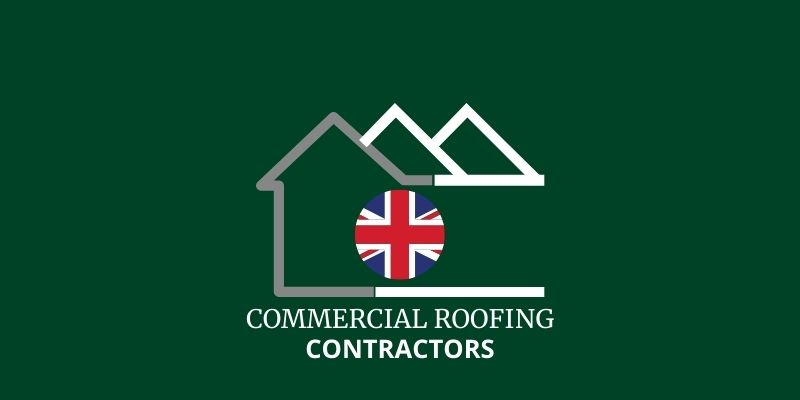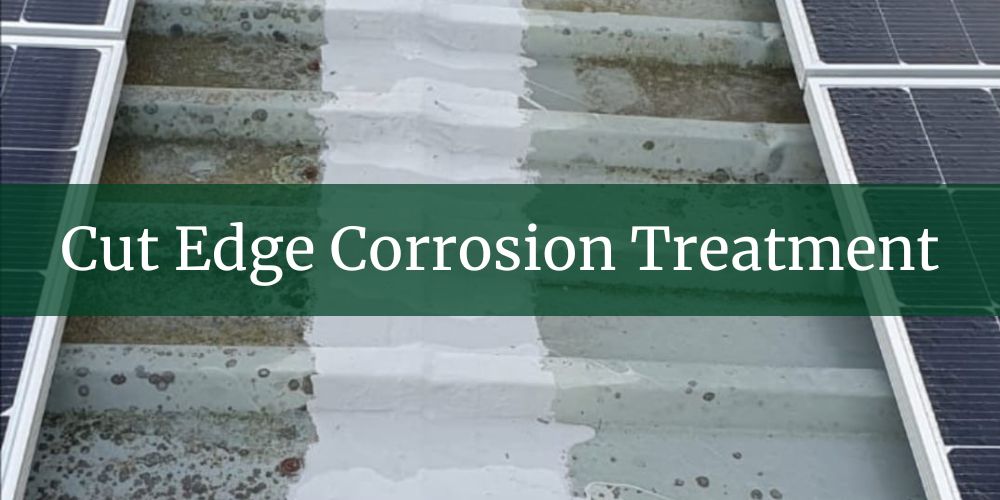Cut edge corrosion is the deterioration of the exposed edges of metal roof sheets where the protective coating has been cut during installation. This corrosion typically begins at the sheet ends and laps, where water exposure and oxygen cause the bare metal to rust. In the UK’s damp climate, the problem can quickly worsen, leading to peeling coatings, compromised watertightness, and eventual structural damage if left untreated. Cut edge corrosion is common on older profiled steel roofs and often requires treatment using specialised coatings to arrest further decay and restore protection. Commercial Roofing Contractors provide cut edge corrosion treatment and cut edge corrosion repairs all over the UK.
Cut edge corrosion in the United Kingdom requires targeted repair solutions due to the country's variable weather conditions, which can accelerate deterioration if left unaddressed. These environmental factors, coupled with the frequent rainfall and temperature fluctuations, can exacerbate corrosion along edges and laps of metal sheeting commonly used in commercial roofing and cladding. Addressing these issues with specific treatments not only prevents further structural damage but also extends the lifespan of affected materials, ensuring long-term protection and maintaining aesthetic appeal. Failing to treat cut edge corrosion can lead to extensive damage, causing water ingress that affects the building's interior and potentially leading to significant repair costs. Targeted repair solutions, such as specific coatings and sealants, are essential to restore affected areas and prevent corrosion spread, thereby ensuring that buildings remain weather-tight and structurally sound.
For commercial property owners and facility managers in the United Kingdom, understanding the importance of addressing cut edge corrosion can prevent costly damage and maintain structural integrity. In this blog, we will delve deeper into the causes of cut edge corrosion, explore various repair techniques, and offer expert advice on maintaining your building's exterior against the UK’s challenging weather conditions.
What is Cut Edge Corrosion and How Does It Affect Commercial Roofing?
Cut edge corrosion is the deterioration of metal roofing's exposed and untreated edges, leading to leaks and structural weakness. It occurs when the protective coating on metal sheets wears away due to weather exposure, causing the metal beneath to rust. This can compromise the integrity of commercial roofing systems, escalating maintenance costs and potentially leading to significant water damage. Understanding the implications of cut edge corrosion is vital for maintaining commercial roofing systems. Here are key aspects to consider:
- Corrosion Process: Begins at unprotected edges, causing rust and decay.
- Structural Impact: Weakened panels might compromise overall roof stability and safety.
- Water Ingress Risk: Increased chance of leaks and interior water damage concerns.
- Cost Implications: Rising repair expenses if issues remain unaddressed.
- Preventative Measures: Regular maintenance and protective treatments safeguard roofing investments.
1. Corrosion Process: Begins at unprotected edges, causing rust and decay.
Corrosion is the process wherein metals deteriorate due to reactions with environmental elements. On metal roofs, this chiefly affects cut edges lacking protective coatings, prompting rust formation. This unmanaged corrosion not only degrades the metal but can also spread, affecting adjacent areas. Addressing these vulnerable points early can prevent severe deterioration and maintain the roof's structural integrity.
2.Structural Impact: Weakened panels might compromise overall roof stability and safety.
Structural impact refers to the effect on a building's essential divisions. As corrosion progresses, metal panels weaken, posing potential risks to roof stability and safety. If not promptly resolved, this can lead to larger structural problems, compromising the building's safety standards.
3. Water Ingress Risk: Increased chance of leaks and interior water damage concerns.
Water ingress is the unwanted water penetration into a building. Corroded metal easily allows water seepage, escalating the likelihood of leaks and interior damage. Proactive roofing solutions are pivotal to precluding such unwanted occurrences, safeguarding interior spaces.
4. Cost Implications: Rising repair expenses if issues remain unaddressed.
Cost implications refer to the financial consequences of managing roofing issues. Unaddressed cut edge corrosion can lead to costly repairs due to extensive damage. Investing in preventative measures can equate to significant long-term savings. This financial foresight helps avoid unexpected, expensive interventions.
5. Preventative Measures: Regular maintenance and protective treatments safeguard roofing investments.
Preventative measures are strategies employed to avert potential problems. Adopting regular maintenance protocols and applying protective treatments can mitigate cut edge corrosion. These include sealants or paint to shield exposed metal. Such proactive measures not only prolong the roof's lifespan but protect your investment, ensuring longevity and performance.
Have a question about an upcoming project?
Why Are Standard Repair Methods Insufficient for Tackling Cut Edge Corrosion?
Standard repair methods fail because they often don't address underlying moisture and material degradation issues. Cut edge corrosion, typically seen on metal roofing, progresses from the unprotected edges inward, requiring specialised approaches for effective management. These methods often don't offer a long-term solution, leaving roofs vulnerable to further damage and costly repairs.
Here are the key reasons why standard repair methods fall short when addressing cut edge corrosion:
- Lack of Moisture Barrier: Doesn't adequately halt underlying moisture ingress.
- Material Compatibility: Standard materials may not bond well with existing substrates.
- Surface Preparation: Inadequate preparation leads to ineffective corrosion control.
- Temporary Fix: Often only provides a short-term solution.
- Neglect of Structural Integrity: Overlooks the reinforcement of affected areas.
1. Lack of Moisture Barrier: Doesn't adequately halt underlying moisture ingress.
A moisture barrier is a layer that prevents water from seeping through surfaces. In cut edge corrosion, moisture ingress accelerates deterioration, something standard repairs often miss. Without effective barriers, water can continue to corrode metal surfaces from within, leading to premature failures. Addressing this requires specialised coatings or sealants engineered to bond with metal surfaces, ensuring long-lasting protection against water penetration.
2. Material Compatibility: Standard materials may not bond well with existing substrates.
Material compatibility refers to the ability of repair materials to adhere firmly to existing surfaces. Standard repairs often use generic solutions that might not suit all substrates, leading to poor adhesion and peeling. This can leave the cut edges exposed, allowing corrosion to spread. Specialised coatings designed for metal roofs ensure proper bonding, effectively protecting the surface and extending its life.
3. Surface Preparation: Inadequate preparation leads to ineffective corrosion control.
Surface preparation involves cleaning and priming a surface to receive new coatings effectively. Standard methods may skip critical preparation steps, resulting in coatings that fail to adhere or protect adequately. This makes it easier for corrosion to continue and compromise roof integrity. Proper preparation includes removing rust, cleaning, and priming surfaces to ensure optimal adherence and performance of protective coatings.
4. Temporary Fix: Often only provides a short-term solution.
A temporary fix is a solution that addresses an issue only briefly without permanently resolving it. Standard repairs tend to offer short-lived protection, necessitating frequent intervention to maintain roof health. This is particularly ineffective in managing ongoing cut edge corrosion. A permanent solution involves using specialised corrosion-inhibiting products that fortify the roof's vulnerable edges against future degradation.
5. Neglect of Structural Integrity: Overlooks the reinforcement of affected areas.
Structural integrity refers to the roof's strength and ability to bear loads without breaking. Standard repairs often focus on surface fixes, neglecting to reinforce weakened areas, which could compromise the entire roof system over time. They can fail to address the underlying issues that significantly affect durability. Specialist interventions evaluate and address both the aesthetic and structural components, ensuring comprehensive repair and sustained roof performance.
What Targeted Repair Solutions Are Available for Cut Edge Corrosion in Commercial Roofs?
Cut edge corrosion can be effectively managed with targeted repair solutions involving protective coatings and edge protection systems. These solutions aim to prevent further degradation by sealing exposed metal edges and providing additional barriers against environmental factors. Proper assessment and timely application of these methods are crucial to ensure the longevity of commercial roofing systems. Here are five targeted repair solutions for addressing cut edge corrosion on commercial roofs:
- Specialist Coatings: Application of corrosion-resistant paints or sealants.
- Edge Protection Systems: Install protective strips or barriers along metal edges.
- Regular Maintenance: Conduct routine inspections to identify early signs of corrosion.
- Metal Replacement: Replace severely corroded metal sections as necessary.
- Weatherproofing Measures: Enhance sealants to increase protection against moisture ingress.
1. Specialist Coatings: Application of corrosion-resistant paints or sealants.
Specialist coatings refer to specific paints or sealants that inhibit corrosion. These products are applied to corroded edges to form a barrier against moisture and other environmental factors that accelerate corrosion. Protecting metal edges with these coatings can significantly prolong the life of a commercial roof by slowing the oxidation process.
2. Edge Protection Systems: Install protective strips or barriers along metal edges.
Edge protection systems involve installing physical barriers over vulnerable metal edges. This method not only covers exposed areas but also adds an extra level of protection against environmental exposure. Implementing these systems can effectively reduce the risk of corrosion by preventing direct contact with corrosive agents.
3. Regular Maintenance: Conduct routine inspections to identify early signs of corrosion.
Regular maintenance encompasses routine checks and inspections of roofing materials. Identifying early signs of corrosion through maintenance allows for timely intervention with less extensive repair methods. This proactive approach helps in addressing potential problematic areas before they worsen, thereby reducing long-term repair costs.
4. Metal Replacement: Replace severely corroded metal sections as necessary.
Metal replacement entails removing and installing new metal sections where corrosion is beyond treatment. When protective measures fail or are delayed, replacing the affected areas becomes the most effective solution. While initially more costly, this intervention is necessary to maintain the roof's structural integrity.
5. Weatherproofing Measures: Enhance sealants to increase protection against moisture ingress.
Weatherproofing measures involve applying or upgrading sealants around roof edges to prevent water entry. Enhanced sealants are vital for maintaining a dry and protected substructure, reducing the risk of corrosion. By fortifying the roof against water ingress, the longevity of roofing materials is substantially increased.
Cut edge corrosion is a critical issue that demands targeted repair solutions, especially within the realm of commercial roofing in the United Kingdom. The harsh British climate, characterised by frequent rain and varying temperatures, exacerbates the degradation process, leading to potential leaks and structural damage if left unattended. By adopting prompt and specialised repair techniques, businesses can ensure the longevity and integrity of their roofing systems. Understanding the specific challenges and tailored approaches required for combating cut edge corrosion is essential for maintaining commercial properties efficiently and cost-effectively. Partnering with experts in the field allows building owners to navigate these challenges adeptly, ensuring the safety and durability of their assets while also enhancing energy efficiency and reducing future maintenance costs.
If your commercial property in the United Kingdom requires expert attention for cut edge corrosion or you need a comprehensive assessment of your roofing needs, please reach out to us through our contact form. Our dedicated team at Commercial Roofing Contractors are eager to assist with bespoke solutions, ensuring your roofing system remains in top condition amid the UK's demanding weather conditions.

